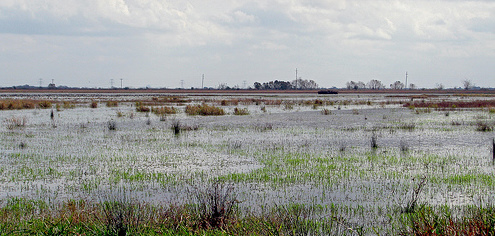Wintering waterfowl such as ducks and geese go hand-in-hand with agricultural fields. Crop fields such as corn, milo, and soybeans provide great wildlife habitat for waterfowl and landowners should implement habitat management to not only provide areas for winter-stressed birds to go, but also provide recreational activities and possibly even another form of income. Many wildlife professionals know that winter flooding of ag fields is beneficial for migrating wildlife, but the impacts to the farmer were unknown. That is why a four year research project was developed to study the impacts of ag field habitat management on crops. Here is what the study found:
Winter flooding did not affect crop production in the seasons following flooding even though the fields provided great duck habitat during the winter. Crop yields did not differ among flooded and nonflooded fields. In fact, yields from flooded fields were slightly greater than county-wide averages in the years during the study. Could this be because of natural fertilizers ducks and geese deposited while on site?
Fields where water was held until April 1st (just before planting season) had significantly fewer spring weeds than fields drained February 1st and fields that were not experimentally flooded. Plants were unable to grow in flooded areas. And geese, which love weeds, do a great job of foraging on many plants farmers do not desire in their fields.

The study also found that winter flooding had no effect on soil fertility. No differences were found in flooded or non-flooded fields before, during or after the study. And that’s good news. Many people thought that flooding could possibly degrade soil fertility, but it seems that habitat management for ducks and geese through flooding has no impact of ag fields.
In addition, research found that there were no short-term differences in sedimentation or soil loss rates between flooded or non-flooded fields managed for wintering waterfowl. It is reasonable to assume, however, that over several years, soil would be retained, or even added, in fields surrounded with terraces on the downslope side, so the practice of habitat management can pay dividends for soil management and construction.
Even though fields were not managed specifically to attract wetland birds, over 50 bird species were observed using the study fields during the winter season. Bird use of the fields increased by 332 percent during the length of the study with no difference in use among study units. Bird groups observed included ducks, geese, wading birds, shorebirds, gulls, terns, and various upland birds (e.g., songbirds, blackbirds and doves). More than 15,000 birds were counted using the habitat provided while the six fields were flooded during the winters of the four year wildlife research project.
Flooding crop fields in winter to attract waterfowl and other wildlife is a management tool that has been used for several years. Ducks and geese are attracted to waste grain and weed seeds, while shorebirds, wading birds and mammals visit flooded fields in search of fish and/or invertebrates. Landowners are interested in this management practice because flooding fields in winter provides a place to hunt (or lease) and is visually pleasing with a variety of wildlife species using the property. In addition, there is evidence that flooding crop fields is actually cost-effective for the producer by providing increased weed control and decreased sedimentation rates.